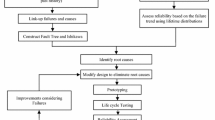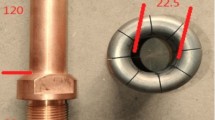Abstract
The main function of Secondary Isolating Contacts (SICs) is to provide power supply to accessories in Air Circuit Breaker (ACB). A new SIC identified, had more number of contacts in a very compact design. There was a need for developing a mechanism to mount these SICs by having a key focus on compactness, alignment and tolerance in ACBs along with high probability of survival for the defined period and operation, to ensure repeated and prolonged use without failure in performance. After the development of mechanism, lifetime distributions were used to assess the reliability of the mechanism, based on the results obtained from operating reliability of the mechanism, modifications were done to improve the reliability. After subsequent developments and modifications in design, reliability of the mechanism increased from 14 to 88% in phase I to phase III respectively. The new arrangement can save up to 25% of the cost compared to current designs. Companies using such SICs can become more competitive, and pass on the cost savings benefits to end users. The volume of SIC and weight of plastic were reduced by approximately 66 and 70%, respectively. The amount of non-degradable waste entering the environment will be considerably reduced.














Similar content being viewed by others
References
Almalki SJ, Yuan J (2013) The new modified Weibull distribution. Reliab Eng Syst Saf 111:164–170
Artana KB, Ishida K (2002) Spreadsheet Modeling of optimal maintenance schedule for components in wear-out phase. Reliab Eng Syst Saf 77:81–91
Asgharzadeh A, Valiollahi R, Raqab MZ (2011) Stress-strength reliability of Weibull distribution based on progressively censored samples. SORT 35(2):103–124
Bebbington M, Laia CD, Zitikis R (2007) A flexible Weibull extension. Reliab Eng Syst Saf 92:719–726
Bertsche B (2007) Reliability in Automotive and Mechanical Engineering. Springer, Berlin, Heidelberg, 35–60. doi:10.1007/978-3-540-34282-3
Bichon BJ, McFarland JM, Mahadevan S (2011) Efficient surrogate models for reliability analysis of systems with multiple failure modes. Reliab Eng Syst Saf 96:1386–1395
Billinton R, Karki R (2010) Incorporating wind power in generating system reliability evaluation. Int J Syst Assur Eng Manag 1(2):120–128
Bourezg A, Meglouli H (2014) Reliability analysis of breaker arrangements in distribution substations. Int J Syst Assur Eng Manag 8(1):531–537
Bourezg A, Meglouli H (2017) Reliability analysis of breaker arrangements in distribution substations. Int J Syst Assur Eng Manag. doi:10.1007/s13198-014-0282-x
Bourouni K (2013) Availability assessment of a reverse osmosis plant: Comparison between Reliability Block Diagram and Fault Tree Analysis Methods. Desalin 313:66–76
Chaturvedi A, Malhotra A (2016) Estimation and testing procedures for the reliability functions of a family of lifetime distributions based on records. Int J Syst Assur Eng Manag. doi:10.1007/s13198-016-0531-2
Chen C (2006) Tests of fit for the three-parameter lognormal distribution. Comput Stat Data Anal 50:1418–1440
Cooper J. (2017) An overview of reliability. Pan Pacific Microelectronics Symposium (Pan Pacific): Kauai, HI 1–5
Demir M, Kahramanoğlu G and Bekir Yıldız A. (2016) Importance of reliability for power electronic circuits, case study: Inrush current test and calculating of fuse melting point. IEEE International Power Electronics and Motion Control Conference (PEMC), Varna, 830–834. doi: 10.1109/EPEPEMC.2016.7752101
Djeddi AZ, Hafaifa A, Kouzou A et al (2016) Exploration of reliability algorithms using modified Weibull distribution: application on gas turbine. Int J Syst Assur Eng Manag. doi:10.1007/s13198-016-0480-9
Fajdiga M, Jurejevčič T, Kernc J (1996) Reliability prediction in early phases of product design. J Eng Des 7(2):107–128
Fisher FE, Fisher JR (2000) Probability applications in mechanical design. Marcel Dekker, New York, pp 200–205
Jiang R, Murthy DNP (2011) A study of Weibull shape parameter: properties and significance. Reliab Eng Syst Saf 96:1619–1626
Kapur PK, Kumar U (2016) Special issue on reliability, infocomm technology and business operations. Int J Syst Assur Eng Manag. doi:10.1007/s13198-016-0537-9
Khorshidi HA, Gunawan I, Ibrahim MY (2015) Data-driven system reliability and failure behavior modelling using FMECA” Industrial Informatics. IEEE Trans. doi:10.1109/TII.2015.243122
Kim JS, Yum B (2008) Selection between Weibull and lognormal distributions: a comparative simulation study. Comput Stat Data Anal 53:477–485
Klein J.P. and Moeschberger M.L. (2010) Survival analysis: techniques for censored and truncated data. 2nd ed. New York: Springer
Kumar S, Chattopadhyay G, Kumar U (2007) Reliability improvement through alternative designs—A case study. Reliab Eng Syst Saf 92:983–991
Lougha KG, Stonea R, Tumer IY (2009) The risk in early design method. J Eng Des 20(2):155–173
Marković D, Jukic D (2010) On nonlinear weighted total least squares parameter estimation problem for the three-parameter Weibull density. Appl Math Model 34:1839–1848
McPherson JW (2010) Reliability physics and engineering Time-To-Failure Modeling. Springer, Berlin
Moeini A, Jenab K, Mohammadi M, Foumani M (2013) Fitting the three-parameter Weibull distribution with Cross Entropy. Appl Math Model 37:6354–6363
Mohammadian SH, Aı¨t-Kadi D (2010) Design stage confirmation of life time improvement for newly modified products through accelerated life testing. Reliab Eng Syst Saf 95:897–905
Mostafaeipour A (2016) A novel innovative design improvement using value engineering technique: a case study. J Optim Ind Eng 9(19):25–36
Nagatsuka H, Kamakurab T, Balakrishnan N (2013) A consistent method of estimation for the three-parameter Weibull distribution. Comput Stat Data Anal 58:210–226
Nichols K (1992) Designing for quality and reliability. J Eng Des 3(2):139–148
Pang W, Leung P, Huang W, Liu W (2005) On interval estimation of the coefficient of variation for the three-parameter Weibull, lognormal and gamma distribution: a simulation-based approach. Eur J Oper Res 164:367–377
Military handbook: electronic reliability design handbook <http://relex.com/resources/mil/338b.pdf>; 1988
Rane SB, Narvel YAM (2015) Reliability assessment and improvement of air circuit breaker (ACB) mechanism by identifying and eliminating the root causes. Int J Syst Assur Eng Manag. doi:10.1007/s13198-015-0405-z
Sinha RS, Mukhopadhyay AK (2015) Reliability centered maintenance of cone crusher: a case study. Int J Syst Assur Eng Manag. 6(1):32–35
Smitha J, Clarkson PJ (2005) Design concept modelling to improve reliability. J Eng Des 16(5):473–492
Stapleberg RF (2009) Handbook of reliability, availability, maintainability and safety in engineering design. Springer, London, pp 45–55. doi:10.1007/978-1-84800-175-6
Tang J (2001) Mechanical system reliability analysis using a combination of graph theory and Boolean function. Reliab Eng Syst Safy 72:21–30
Venu VV, Verma AK (2010) Reliability of electric power systems: challenges in the deregulated environment–a research perspective. Int J Syst Assur Eng Manag. 1:24–31
Vera JF, Díaz-García JA (2008) A global simulated annealing heuristic for the three-parameter lognormal maximum likelihood estimation. Comput Stat Data Anal 52:5055–5065
Wang Y, Wu X, Zhou Z, Li Y (2003) Investigation of reliability and lifetime distribution of the gas sensors based on C2H5OH. Solid-State Electron 47:107–110
Yadav OP, Singh N, Goel PS (2006) Reliability demonstration test planning: a three dimensional consideration. Reliab Eng Syst Saf 91:882–893
Zhang T, Dwight R (2013) Choosing an optimal model for failure data analysis by graphical approach. Reliab Eng Syst Saf 115:111–123
Zhang X, Gockenbacha E, Liub Z, Chenc H, Yangc L (2013) Reliability estimation of high voltage SF6 circuit breakers by statistical analysis on the basis of the field data. Electr Power Syst Res 103:105–113
Acknowledgments
This research paper was made possible through the resources and help provided by two great organizations, namely Sardar Patel College of Engineering and Larsen & Toubro Switchgear Ltd.
We sincerely wish to acknowledge a deep sense of gratitude for the valuable guidance, suggestions and generous help extended by Satyaprakash Sharma. In addition, we would like to thank S.S. Ahluwalia for his great help and co-operation. We are also very thankful to Abdul Aziz Gazdar who actually read our paper at micro level and gave us many valuable suggestions.
We sincerely thank all the authors who made available sufficient literature in this domain that helped us and kept us in the right direction.
The product of this research paper would not have been possible without all of them.
Author information
Authors and Affiliations
Corresponding author
Rights and permissions
About this article
Cite this article
Rane, S.B., Narvel, Y.A. & Khatua, N. Development of mechanism for mounting secondary isolating contacts (SICs) in air circuit breakers (ACBs) with high operational reliability. Int J Syst Assur Eng Manag 8 (Suppl 2), 1816–1831 (2017). https://doi.org/10.1007/s13198-017-0678-5
Received:
Revised:
Published:
Issue Date:
DOI: https://doi.org/10.1007/s13198-017-0678-5




